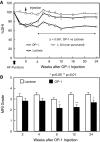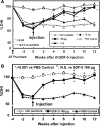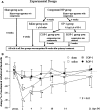Biological repair of the degenerated intervertebral disc by the injection of growth factors
- PMID: 19005698
- PMCID: PMC2587664
- DOI: 10.1007/s00586-008-0749-z
Biological repair of the degenerated intervertebral disc by the injection of growth factors
Abstract
The homeostasis of intervertebral disc (IVD) tissues is accomplished through a complex and precise coordination of a variety of substances, including cytokines, growth factors, enzymes and enzyme inhibitors. Recent biological therapeutic strategies for disc degeneration have included attempts to up-regulate the production of key matrix proteins or to down-regulate the catabolic events induced by pro-inflammatory cytokines. Several approaches to deliver these therapeutic biologic agents have been proposed and tested in a preclinical setting. One of the most advanced biological therapeutic approaches to regenerate or repair a degenerated disc is the injection of a recombinant growth factor. Abundant evidence for the efficacy of growth factor injection therapy for the treatment of IVD degeneration can be found in preclinical animal studies. Recent data obtained from animal studies on changes in cytokine expression following growth factor injection illustrate the great potential for patients with chronic discogenic low back pain. The first clinical trial for growth factor injection has been initiated and the results of that study may prove the usefulness of growth factor injection for treating the symptoms of patients with degenerative disc diseases. The focus of this review article is the effects of an in vivo injection of growth factors on the biological repair of the degenerated intervertebral disc in animal models. The effects of growth factor injection on the symptoms of patients with low back pain, the therapeutic target of growth factor injection and the limitations of the efficacy of growth factor therapy are also reviewed. Further quantitative studies on the effect of growth factor injection on pain generation and the long term effects on the endplate and cell survival after an injection using large animals are needed. An international academic-industrial consortium addressing these aims, such as was achieved for osteoarthritis (The Osteoarthritis Initiative), may further the development of biological therapies for degenerative disc diseases.
Figures






Similar articles
-
Prevention of disc degeneration with growth factors.Eur Spine J. 2006 Aug;15 Suppl 3(Suppl 3):S422-32. doi: 10.1007/s00586-006-0149-1. Epub 2006 Jul 25. Eur Spine J. 2006. PMID: 16865380 Free PMC article. Review.
-
Molecular therapy of the intervertebral disc.Eur Spine J. 2006 Aug;15 Suppl 3(Suppl 3):S379-88. doi: 10.1007/s00586-006-0155-3. Epub 2006 Jul 12. Eur Spine J. 2006. PMID: 16835736 Free PMC article. Review.
-
Growth factor expression in degenerated intervertebral disc tissue. An immunohistochemical analysis of transforming growth factor beta, fibroblast growth factor and platelet-derived growth factor.Eur Spine J. 2006 May;15(5):588-96. doi: 10.1007/s00586-005-0930-6. Epub 2005 Jun 25. Eur Spine J. 2006. PMID: 15980999 Free PMC article.
-
Growth factors and treatment of intervertebral disc degeneration.Spine (Phila Pa 1976). 2004 Dec 1;29(23):2757-69. doi: 10.1097/01.brs.0000146048.14946.af. Spine (Phila Pa 1976). 2004. PMID: 15564925 Review.
-
Degeneration of Lumbar Intervertebral Discs: Characterization of Anulus Fibrosus Tissue and Cells of Different Degeneration Grades.Int J Mol Sci. 2020 Mar 21;21(6):2165. doi: 10.3390/ijms21062165. Int J Mol Sci. 2020. PMID: 32245213 Free PMC article.
Cited by
-
Does the Intradiscal Injection of Platelet Rich Plasma Have Any Beneficial Role in the Management of Lumbar Disc Disease?Global Spine J. 2022 Apr;12(3):503-514. doi: 10.1177/2192568221998367. Epub 2021 Apr 12. Global Spine J. 2022. PMID: 33840260 Free PMC article.
-
Fibrin-Hyaluronic Acid Hydrogel (RegenoGel) with Fibroblast Growth Factor-18 for In Vitro 3D Culture of Human and Bovine Nucleus Pulposus Cells.Int J Mol Sci. 2019 Oct 11;20(20):5036. doi: 10.3390/ijms20205036. Int J Mol Sci. 2019. PMID: 31614494 Free PMC article.
-
Stem cell therapy in discogenic back pain.J Spine Surg. 2019 Dec;5(4):561-583. doi: 10.21037/jss.2019.09.22. J Spine Surg. 2019. PMID: 32043007 Free PMC article. Review.
-
Evaluation of Lumbar Intervertebral Disc Degeneration Using T1ρ and T2 Magnetic Resonance Imaging in a Rabbit Disc Injury Model.Asian Spine J. 2018 Apr;12(2):317-324. doi: 10.4184/asj.2018.12.2.317. Epub 2018 Apr 16. Asian Spine J. 2018. PMID: 29713414 Free PMC article.
-
Molecular profile of major growth factors in lumbar intervertebral disc herniation: Correlation with patient clinical and epidemiological characteristics.Mol Med Rep. 2017 Apr;15(4):2195-2203. doi: 10.3892/mmr.2017.6221. Epub 2017 Feb 20. Mol Med Rep. 2017. PMID: 28260009 Free PMC article.
References
-
- Masuda K, Oegema TR, Jr, An HS. Growth factors and treatment of intervertebral disc degeneration. Spine. 2004;29:2757–2769. doi: 10.1097/01.brs.0000146048.14946.af. - DOI - PubMed
-
- Kang JD, Georgescu HI, McIntyre-Larkin L, Stefanovic-Racic M, Donaldson WF, 3rd, Evans CH. Herniated lumbar intervertebral discs spontaneously produce matrix metalloproteinases, nitric oxide, interleukin-6, and prostaglandin E2. Spine. 1996;21:271–277. doi: 10.1097/00007632-199602010-00003. - DOI - PubMed
Publication types
MeSH terms
Substances
LinkOut - more resources
Full Text Sources
Other Literature Sources
Medical

